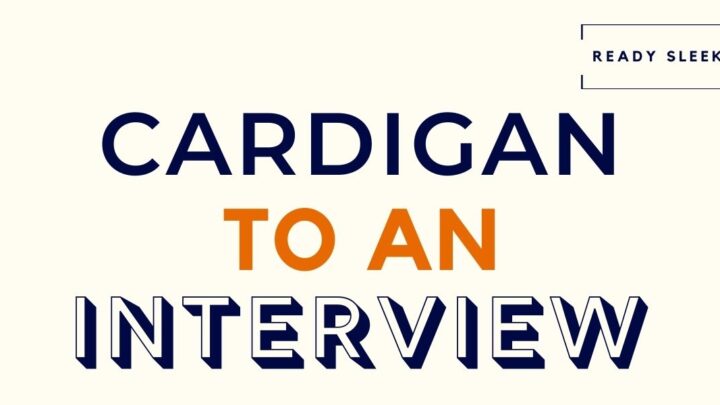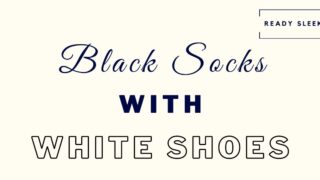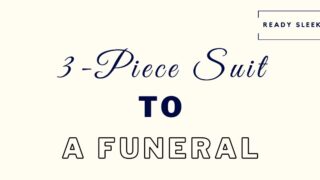Clothing is a common source of stress before an interview. It can be tough to know what’ll look good and more importantly what won’t offend an interviewer. So, can you wear a cardigan to an interview?
Cardigans can be worn to interviews where the workplace dress code could be considered business-casual. Lightweight, V-neck cardigans in a dark and neutral color work well, especially when paired with a dress shirt and a knit tie.
Although that’s the short answer, there’s a whole lot more to it.
Here are some essential tips for wearing a cardigan to an interview in the most professional way possible.
Let’s get to it.
1. Make Sure It’s Appropriate First
Before you pop on the cardigan, make sure it’s OK to wear in the first place. There are certain industries and work settings where you’d be better off wearing something else.
If you’ve received instructions specifically telling you to dress a certain way, ignore everything and listen to what they say.
If you’ve got anyone on the inside already working at the place you’re applying to, it’s definitely worth getting their opinion as well.
But if you’ve got no idea whether a cardigan would be appropriate for the specific interview you’re attending, here are a few principles you can stick to.
If the job you’re applying to is clearly a formal, corporate office setting, don’t wear a cardigan. You’ll be wearing a formal business-professional suit and a cardigan will always fall more on the “business-casual” end of the spectrum.
While it wouldn’t be the worst thing you could wear, try to avoid wearing a cardigan where you’re sure you need to dress formally.
If the job you’re applying to has more of a relaxed, business-casual dress code, you’d quite easily be able to wear a cardigan to the interview. Sticking to the other tips on this list will help you do so properly.
Finally, you’ve got work settings where the work requires that you wear a uniform (eg. custodial services or retail).
In these cases, a cardigan would also be absolutely fine.
While you’ve probably got a lot more freedom to wear what you want to the interview, sticking to the tips in this list in any case should make sure you don’t set a foot wrong.
2. Lightweight Cardigans Work Best
Lightweight, V-neck open-front cardigans work best for interviews.
While most cardigans share the common feature of being a knitted sweater with an open front (usually buttoned), there are different types.
The main ones are as follows:
- V-neck open front: Lightweight, often made from merino wool or cashmere. These are the easiest to dress up and wear with more formal attire.
- Shawl collar: A little heavier usually, with a distinctive shawl collar. They look a little more casual than V-necks.
- Cable-knit: Heavy, with a rugged knit texture. The most casual type of cardigan.
For an interview where you feel as though a cardigan would be appropriate (i.e business casual settings) but you don’t want to risk underdressing, lightweight V-necks are better.
Here’s an example of a V-neck cardigan on Amazon:

They’re just easier to pair with dress shirts, ties, overcoats in a way that works.
Having said that, a shawl collar would also usually work, although they won’t be as good.
Here’s a shawl collar on Amazon. As you can see, it would still work.

But avoid cable-knit cardigans for interviews. They have a very casual look and feel to them.
3. Go For A Dark And Neutral Cardigan
When you’re dressing for an interview, no matter how “relaxed” the workplace might be, you don’t want to take unnecessary risks.
In general, going for darker tones for the core items of your outfit will usually be a safer play.
In addition, going for dark and neutral colors for your cardigan will make sure that you’re easily able to color match it with other items.
Good options include black, charcoal, dark grey, dark brown, and navy blue.
Sticking to this basic principle should ensure that the cardigan doesn’t draw unwanted attention in the way that a brighter or bolder cardigan might.
Always keep things subtle with your sense of dress whenever attending an interview.
Here’s an example of what not to wear to an interview on Amazon. The color is way too bold and the texture of the cable knit just looks too casual:

4. Don’t Button The Bottom Button
While you want to dress conservatively, there’s no sense in throwing generally accepted cardigan etiquette out of the window.
Much like vests and waistcoats, most people will agree that the bottom button of a cardigan shouldn’t be buttoned.
It won’t just feel more comfortable.
It’ll also look more stylish.
It’ll prevent the cardigan from looking or feeling too tight or restrictive.
When you do this, however, it does make it even more important that your shirt is properly tucked in.
There’s nothing worse than a tuft of your shirt hem popping out and showing through from under the unbuttoned portion of your cardigan.
5. Go For A Dress Shirt
When wearing a cardigan, your top two shirt options would be a dress shirt or an Oxford shirt (i.e OCBD).
While the texture of Oxford cloth works very well with that of the knitted cardigan, especially in business-casual outfits, a dress shirt would usually be the safer choice.
Oxford shirts will also look more casual and are also a little harder to pair with ties.
When dressing for an interview, if you ever have a tough choice between a less formal item and a more formal item, it’s usually better to go for the more formal one.
Dress shirts can easily be paired under a cardigan, working especially well with the lightweight V-neck ones.
Go for a light and neutral color with the shirt; it’s very hard to go wrong with white or baby blue.
They’re simple, subtle, and neutral enough to pair with most dark and neutral cardigans.
Once again, be sure the shirt is properly tucked in at all times. It can be hard to tell when you’re wearing a cardigan sometimes.
Shirt stays are an easy way to keep them tucked in if you’re having trouble with this.
6. Knit Ties Work Well
Given how the setting you’re dressing for is likely to be business-casual at most, you don’t need to go for the shiniest mulberry silk necktie.
In fact, a shiny, formal-looking tie like that would probably look quite strange when worn with a cardigan.
The sheen on the tie would clash with the rugged knitted texture of the cardigan.
A knit tie would work especially well when wearing a cardigan to an interview. It’s ideal for business-casual work settings.
However, go for a silk knit tie instead of a wool knit tie. Wool knit ties would usually look a little too casual and rugged to pull off at an interview.
It’s also a great opportunity to add a subtle splash of color to your outfit as a whole. You’ve gone for neutral tones with your dress shirt and cardigan.
Here’s an example of a red knit tie on Amazon that could work well:

Knit ties come in a huge variety of colors to choose from.
You’ll still want to keep things subtle and relatively dark, but a burgundy red, solid blue, or navy would usually be fine.
7. Think Of The Cardigan As A Blazer
Thinking of the cardigan as a blazer can be helpful. In many ways, you’re sticking to the same tips and principles.
You’re using it as an outer layer, over your dress shirt and (probably knit) tie.
Sure, you could wear all of this under a 2-piece suit. There’s no reason why not.
However, you could also choose to keep the cardigan as an outer layer instead of wearing a blazer or suit jacket.
You could simply wear an overcoat over it instead.
You’ve then got to think of what type of pants you’re going to wear with it.
In general, the most casual you should go for would be a pair of chinos. Cardigans work great with chinos, but as always, going for dark and neutral with your choice of chinos would be better.
Dress slacks (i.e dress pants) would be the more formal option, but may not be entirely necessary.
At the end of the day, if you feel you’re able to wear the cardigan to the interview in the first place, it’s probably going to be a business-casual setting.
A pair of dark, tapered chinos would usually be OK here.
And that’s about it.
This tip, as well as the others on this list, should make sure you wear the cardigan stylishly while still remaining professional.
Ready Sleek founder. Obsessed with casual style and the minimalist approach to building a highly functional wardrobe. Also a fan of classic, vintage hairstyles.







